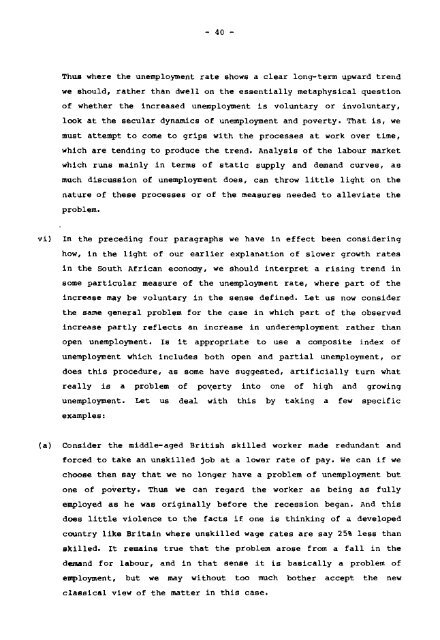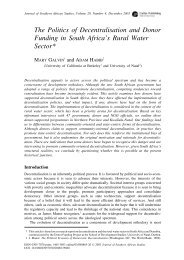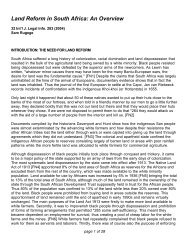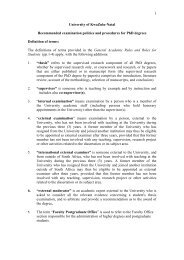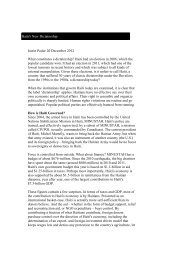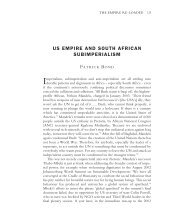Bell, Trevor : Unemployment in South Africa
Bell, Trevor : Unemployment in South Africa
Bell, Trevor : Unemployment in South Africa
Create successful ePaper yourself
Turn your PDF publications into a flip-book with our unique Google optimized e-Paper software.
Thus where the unemployment rate shows a clear long-term upward trend<br />
we should, rather than dwell on the essentially metaphysical question<br />
of whether the <strong>in</strong>creased unemployment is voluntary or <strong>in</strong>voluntary,<br />
look at the secular dynamics of unemployment and poverty. That is, we<br />
must attempt to come to grips with the processes at work over time,<br />
which are tend<strong>in</strong>g to produce the trend. Analysis of the labour market<br />
which runs ma<strong>in</strong>ly <strong>in</strong> terms of static supply and demand curves, as<br />
much discussion of unemployment does, can throw little light on the<br />
nature of these processes or of the measures needed to alleviate the<br />
problem.<br />
vi) In the preced<strong>in</strong>g four paragraphs we have <strong>in</strong> effect been consider<strong>in</strong>g<br />
how, <strong>in</strong> the light of our earlier explanation of slower growth rates<br />
<strong>in</strong> the <strong>South</strong> <strong>Africa</strong>n economy, we should <strong>in</strong>terpret a ris<strong>in</strong>g trend <strong>in</strong><br />
some particular measure of the unemployment rate, where part of the<br />
<strong>in</strong>crease may be voluntary <strong>in</strong> the sense def<strong>in</strong>ed. Let us now consider<br />
the same general problem for the case <strong>in</strong> which part of the observed<br />
<strong>in</strong>crease partly reflects an <strong>in</strong>crease <strong>in</strong> underemployment rather than<br />
open unemployment. Is it appropriate to use a composite <strong>in</strong>dex of<br />
unemployment which <strong>in</strong>cludes both open and partial unemployment, or<br />
does this procedure, as some have suggested, artificially turn what<br />
really is a problem of poyerty <strong>in</strong>to one of high and grow<strong>in</strong>g<br />
unemployment. Let us deal with this by tak<strong>in</strong>g a few specific<br />
examples:<br />
(a) Consider the middle-aged British skilled worker made redundant and<br />
forced to take an unskilled job at a lwer rate of pay. We can if we<br />
choose then say that we no longer have a problem of unemployment but<br />
one of poverty. Thua we can regard the worker as be<strong>in</strong>g as fully<br />
employed as he was orig<strong>in</strong>ally before the recession began. And this<br />
does little violence to the facts if one is th<strong>in</strong>k<strong>in</strong>g of a developed<br />
country like Brita<strong>in</strong> where unskilled wage rates are say 25% less than<br />
skilled. It rema<strong>in</strong>s true that the problem arose from a fall <strong>in</strong> the<br />
dunand for labour, and <strong>in</strong> that sense it is basically a problem of<br />
employment, but we may without too much bother accept the new<br />
classical view of the matter <strong>in</strong> this case.


